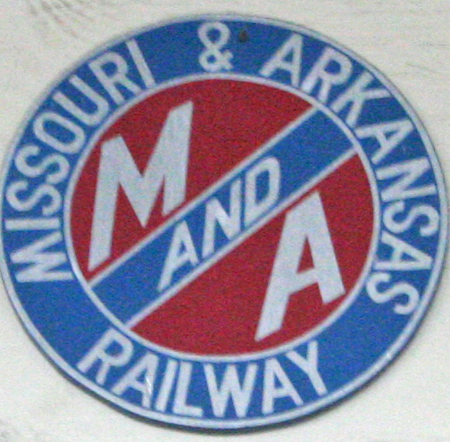 |
Missouri and Arkansas RailroadModeler |
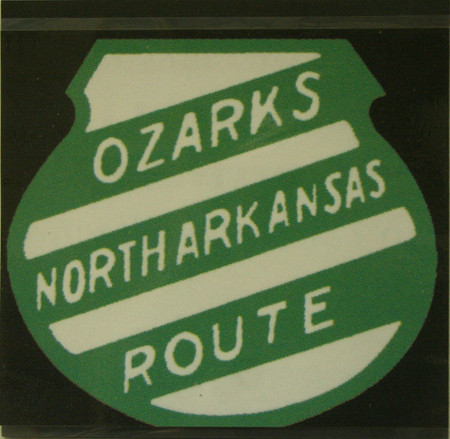 |
| This was published in the Nov. 1976 issue of the alumni magazine of The College of the Ozarks while I taught there. |
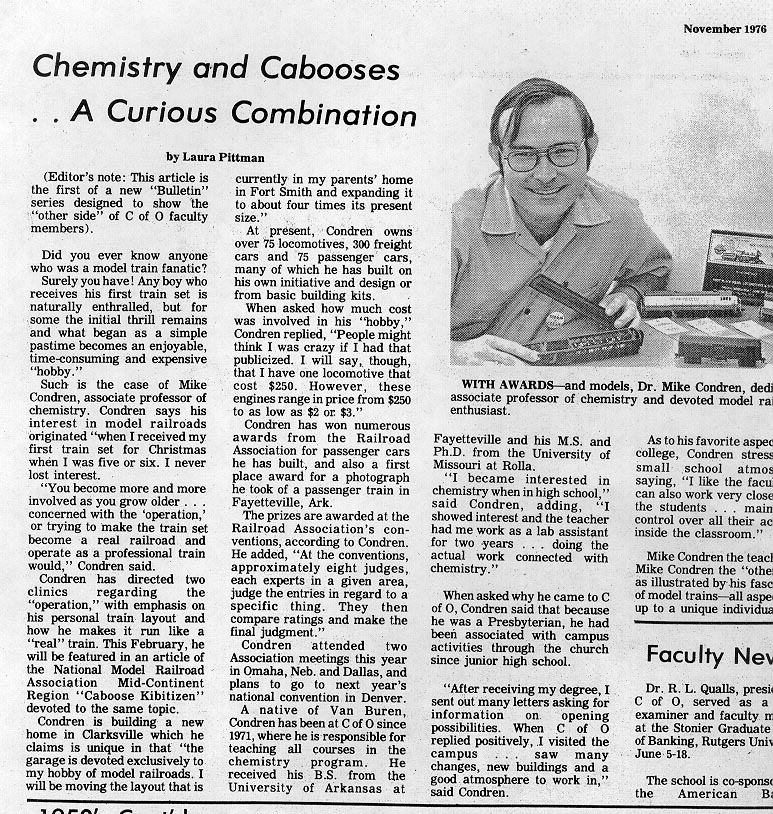 |
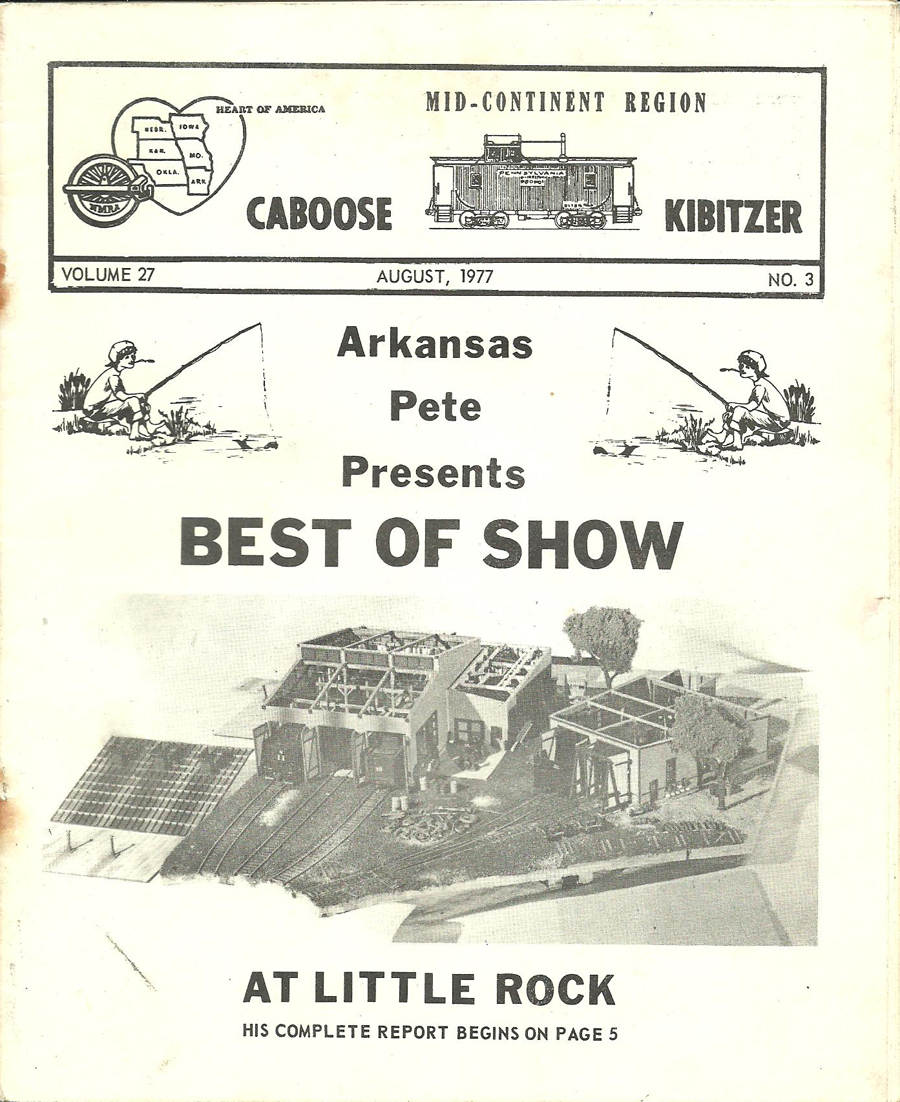 |
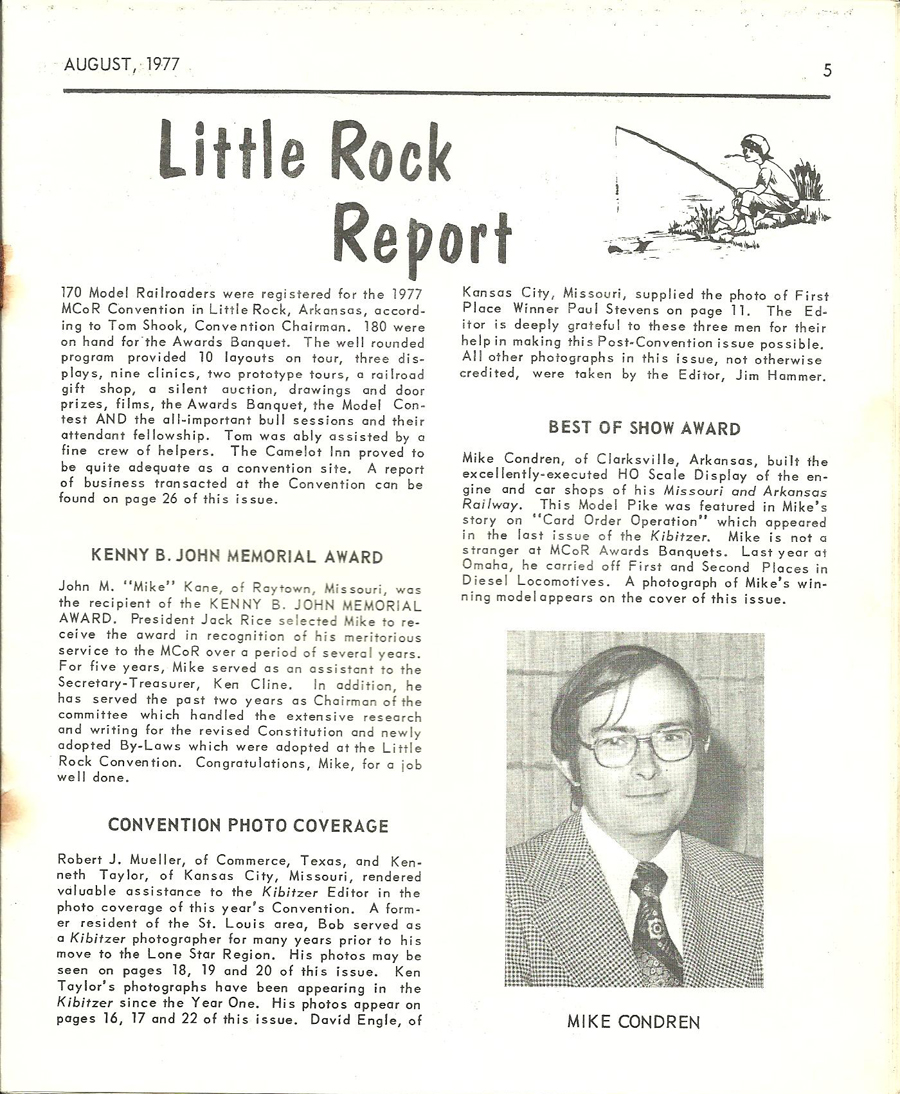 |
Model Railroading – A life Long Passion
As a babe in a carriage, my folks regularly took me to the station to watch the trains. Van Buren was a division point on the Missouri Pacific and a very busy operation during the WWII. After the war, my folks bought me my first electric train for Christmas 1946. (The classic story, my father never had one as a kid, so his kid had to have one so he could play with it.) They bought me an American Flyer set from a local department store. After not being able to get it to run, they took it back and got a Lionel set. I remember one Christmas asking a departmental store Santa Claus for some switches. That got a laugh from those in line until I explained that they were for my train set. When I got old enough to run it my self, dad bought a sheet of ¼” plywood and laid a couple of interconnected circles of track. This layout was located in the entry hall of the apartment house between our apartment and that of the very nice landlady. In junior high dad got a friend who was a switchman on the Missouri Pacific to rebuild the layout with a more complex layout of tracks and switches. He also built a storage unit for extra cars which doubled as the base for the larger transformer and a seat for the operator. I still have that storage case. In 1956, my folks built their first home and my layout got moved to the garage and placed on a hinged cabinet built into the end of the garage. That meant that everything had to be removed, cars, engines, buildings, before the layout could be folded up for the car to get in. There was now room for more track and more track it got. I bought my first issue of Model Railroader in the early 1950s and wore the cover off looking at the layouts inside. I bought my first Trains magazine in KC Union Station in the late 1950s while on a train trip to visit my girl friend in Kansas. Her dad worked for the MP and had gotten reassigned from Van Buren to Hutchinson, KS. While in high school, my mother started my first subscription to Model Railroader just before the 25th anniversary issue. My mother also noticed a story in the newspaper of the formation of a model railroad club in Ft. Smith. I joined and met some life long friends. One, Bill Robbins, went on to buy the Dardanelle and Russellville Railroad which led to the formation of a network of short lines. Another was Gordon Mott who went on to become an assistant to the president of the CSX and later, because of his military training, led the Iraqian railway after the war there. Gordon introduced me to his friend and neighbor Louis Marre who in term introduced me to Jerry Pinkepank and J. David Ingles. Thus began my interest in photography, trains in particular, but not just limited to trains. It was as a member of the Ft. Smith club, that I bought my first HO equipment, first an Athearn Swift refer and then a CofG boxcar. Next was an Athearn rubber-band drive F7 and caboose in SP paint. These later became Frisco models and the F7 was converted to a gear drive. The club met in the former office space for the Frisco Freight House in Ft. Smith. When appropriate we watched trains outside. I well remember the sounds of the Baldwin VO1000 switchers that were the main stay in Ft. Smith. I rode many a mile in the cab during my weekends in college. In 1964 my father got a new job, and they built a new home in Ft. Smith. This layout began in a 5'x15' closet in that home in Ft. Smith, AR. The room was originally intended for a Lionel layout, but I switched to HO while in graduate school. The bench work was built in the garage of their home and moved upstairs to this closet during Spring Break 1972 from my new job at The College of the Ozarks in Clarksville, AR. I worked on the layout on weekends and during the summer. In 1976 my folks informed me that they were going to build a new home in Ft. Smith. My layout would loose its first home. I decided to build my layout a home with provisions for a family, mine or the next owner in Clarksville. I built a garage with a 3 bedroom house attached starting in the fall of 1976. The garage had heat and air, cable TV, an interom to answer the front door, and a work bench area which included space for my washer and drier on which I could set up my darkroom as there were NO windows. Just before it was finished in 1977, I met the woman who would become my wife. She got to pick out the kitchen lighting, everything else was done by the time we got engaged. In Clarksville, I had the track hand laid for my home town of Van Buren and was ready for scenery. Even had a non-scenic Seligman connection to the Frisco. There was a non-sceniced stagging yard for Ft. Smith. Monett never got started there. Then we moved it all to Memphis. At our first house in Memphis, the Frisco part changed to building the hidden stagging yards and hand laying the visible track in Monett. During this time, I trained Kenny Young, a former student in my freshman chemistry class, into hand laying switches. He took it to the next level by hand laying 2 double slip switches at the connection in Monett of the mainline to the wye for the Central Division. Van Buren was going to be an upper deck (That still has not happened). Then we had to move when our son Matt was born. The house was too small. Kenny Young and I turned a 2 car car-port into a train room with AC. We mixed 700 lbs of concrete for the footing across the entry on a day with a heat index of 110 degrees. We covered the interior walls with Masonite after putting fiber glass insulation in. With the help of a CBU student David Raymo, we got all of the 2 layouts up and running and was getting ready to scenic the Monett area when Madison happened. During my absence for a year on my first sabbatical in 1998-99, Chip and Dale took over the train room. They peed on the hidden track corroding it and left their hulls from their nuts everywhere. Kenny and I were never able to catch them or get rid of them otherwise and the work ground to a halt. I posted a Wanted Dead or Alive poster on my office door at the University but noone ever collected the Reward. This move is allowing me to clean up the mess in the train room and try to salvage what I can of the layouts. That is what is taking so long in this move. The filth from the chipmonks is taking a lot of time to clean up. It took a couple of days in the heat to get far enough inside the door to turn on the AC! These pictures will help to inspire me to get back in there next week (written July 31, 2010) and work hard at cleaning and throwing stuff away. There was even a computer desk with a 20 year old computer setup for generating way bills. The computer equipment went to the recycling center in Memphis a couple of weeks ago. I started using the way bill system of Doug Smith that appeared in MR in the mid-to-late-50s on my Lionel layout. When the layout in these photos got built, I switched to a more realistic card system. Some of the early shots of this layout, engines unpainted, not shown, were taken for a clinic I presented at a train meet in Ft. Smith. The clinic concerned car-order operation. There was even a write-up in the Mid-Continent Bulletin of NMRA concerning how I used card-order operation and storage units under Harrison for the cars which I interchanged with the rest of the world. The B&W shots were taken for that article. I have not posted the pictures of cards and such yet. We even had operating sessions in my parents home before the move of the layout to Clarksville with me and 1 other person serving as conductor and engineer. Operating sessions began again in Memphis with me and friends. I am looking forward to such operating sessions in the new home in Tahlequah, OK. |

Home of THE ARKANSAS SCRAMBLER
For questions, email arkyrail at outlook.com